这篇文章主要讲解了“文件写入的方法有哪些”,文中的讲解内容简单清晰,易于学习与理解,下面请大家跟着小编的思路慢慢深入,一起来研究和学习“文件写入的方法有哪些”吧!
0.什么是流?
Java 中的“流”是一种抽象的概念,也是一种比喻,就好比水流一样,水流是从一端流向另一端的,而在 Java 中的“水流”就是数据,数据会从一端“流向”另一端。
根据流的方向性,我们可以将流分为输入流和输出流,当程序需要从数据源中读入数据的时候就会开启一个输入流,相反,写出数据到某个数据源目的地的时候也会开启一个输出流,数据源可以是文件、内存或者网络等。
1.什么是字节流?
字节流的基本单位为字节(Byte),一个字节通常为 8 位,它是用来处理二进制(数据)的。字节流有两个基类:InputStream(输入字节流)和 OutputStream(输出字节流)。
常用字节流的继承关系图如下图所示:
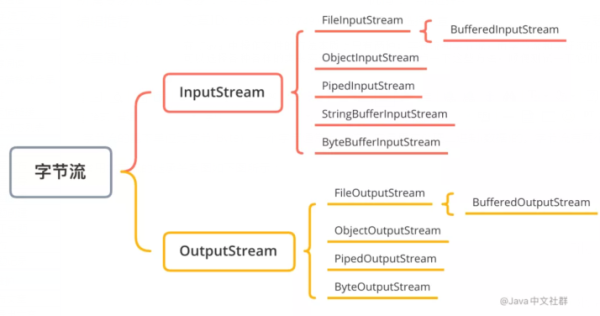
其中 InputStream 用于读操作,而 OutputStream 用于写操作。
2.什么是字符流?
字符流的基本单位为 Unicode,大小为两个字节(Byte),它通常用来处理文本数据。字符流的两个基类:Reader(输入字符流)和 Writer(输出字符流)。
常用字符流的继承关系图如下图所示:
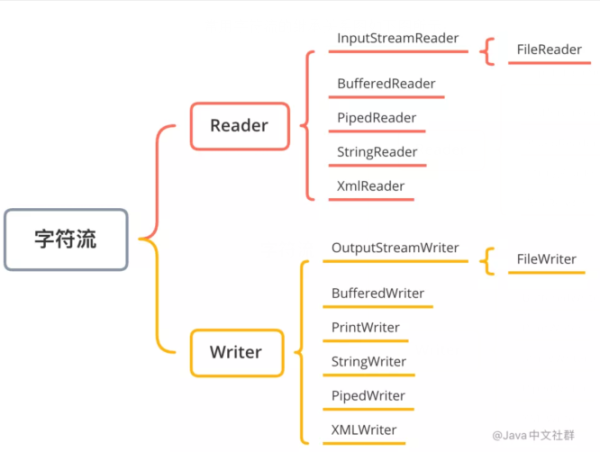
3.流的分类
流可以根据不同的维度进行分类,比如可以根据流的方向进行分类,也可以根据传输的单位进行分类,还可以根据流的功能进行分类,比如以下几个。
① 按流向分类
输出流:OutputStream 和 Writer 为基类。
输入流:InputStream 和 Reader 为基类。
② 根据传输数据单位分类
字节流:OutputStream 和 InputStream 为基类。
字符流:Writer 和 Reader 为基类。
③ 根据功能分类
字节流:可以从或向一个特定的地方(节点)读写数据。
处理流:是对一个已存在的流的连接和封装,通过所封装的流的功能调用实现数据读写。
PS:我们通常是以传输数据的单位来为流进行分类。
4.写文件的6种方法
写入文件的方法主要源于字符流 Writer 和输出字节流 OutputStream 的子类,如下图所示:
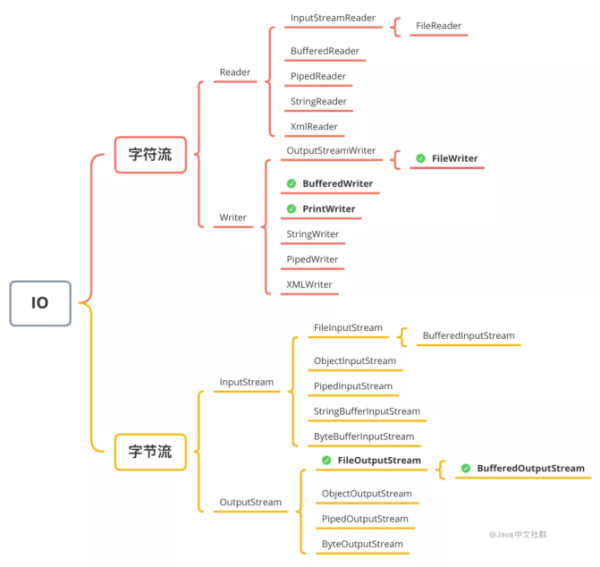
以上标注✅号的类就是用来实现文件写入的类,除此之外,在 JDK 1.7 中还提供了 Files 类用来实现对文件的各种操作,接下来我们分别来看。
方法 1:FileWriter
FileWriter 属于「字符流」体系中的一员,也是文件写入的基础类,它包含 5 个构造函数,可以传递一个具体的文件位置,或者 File 对象,第二参数表示是否要追加文件,默认值为 false 表示重写文件内容,而非追加文件内容(关于如何追加文件,我们后面会讲)。
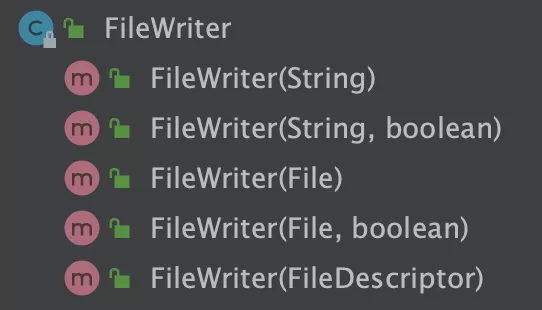
FileWriter 类的实现如下:
/** * 方法 1:使用 FileWriter 写文件 * @param filepath 文件目录 * @param content 待写入内容 * @throws IOException */ public static void fileWriterMethod(String filepath, String content) throws IOException { try (FileWriter fileWriter = new FileWriter(filepath)) { fileWriter.append(content); } }只需要传入具体的文件路径和待写入的内容即可,调用代码如下:
public static void main(String[] args) { fileWriterMethod("/Users/mac/Downloads/io_test/write1.txt", "哈喽,Java中文社群."); }然后我们打开写入的文件,实现结果如下:

关于资源释放的问题:在 JDK 7 以上的版本,我们只需要使用 try-with-resource 的方式就可以实现资源的释放,就比如使用 try (FileWriter fileWriter = new FileWriter(filepath)) {...} 就可以实现 FileWriter 资源的自动释放。
方法 2:BufferedWriter
BufferedWriter 也属于字符流体系的一员,与 FileWriter 不同的是 BufferedWriter自带缓冲区,因此它写入文件的性能更高(下文会对二者进行测试)。
小知识点:缓冲区
缓冲区又称为缓存,它是内存空间的一部分。也就是说,在内存空间中预留了一定的存储空间,这些存储空间用来缓冲输入或输出的数据,这部分预留的空间就叫做缓冲区。
缓冲区的优势
以文件流的写入为例,如果我们不使用缓冲区,那么每次写操作 CPU 都会和低速存储设备也就是磁盘进行交互,那么整个写入文件的速度就会受制于低速的存储设备(磁盘)。但如果使用缓冲区的话,每次写操作会先将数据保存在高速缓冲区内存上,当缓冲区的数据到达某个阈值之后,再将文件一次性写入到磁盘上。因为内存的写入速度远远大于磁盘的写入速度,所以当有了缓冲区之后,文件的写入速度就被大大提升了。
了解了缓存区的优点之后,咱们回到本文的主题,接下来我们用 BufferedWriter 来文件的写入,实现代码如下:
/** * 方法 2:使用 BufferedWriter 写文件 * @param filepath 文件目录 * @param content 待写入内容 * @throws IOException */ public static void bufferedWriterMethod(String filepath, String content) throws IOException { try (BufferedWriter bufferedWriter = new BufferedWriter(new FileWriter(filepath))) { bufferedWriter.write(content); } }调用代码和方法 1 类似,这里就不再赘述了。
方法 3:PrintWriter
PrintWriter 也属于字符流体系中的一员,它虽然叫“字符打印流”,但使用它也可以实现文件的写入,实现代码如下:
/** * 方法 3:使用 PrintWriter 写文件 * @param filepath 文件目录 * @param content 待写入内容 * @throws IOException */ public static void printWriterMethod(String filepath, String content) throws IOException { try (PrintWriter printWriter = new PrintWriter(new FileWriter(filepath))) { printWriter.print(content); } }从上述代码可以看出,无论是 PrintWriter 还是 BufferedWriter 都必须基于 FileWriter 类来完成调用。
方法 4:FileOutputStream
上面 3 个示例是关于字符流写入文件的一些操作,而接下来我们将使用字节流来完成文件写入。我们将使用 String 自带的 getBytes() 方法先将字符串转换成二进制文件,然后再进行文件写入,它的实现代码如下:
/** * 方法 4:使用 FileOutputStream 写文件 * @param filepath 文件目录 * @param content 待写入内容 * @throws IOException */ public static void fileOutputStreamMethod(String filepath, String content) throws IOException { try (FileOutputStream fileOutputStream = new FileOutputStream(filepath)) { byte[] bytes = content.getBytes(); fileOutputStream.write(bytes); } }方法 5:BufferedOutputStream
BufferedOutputStream 属于字节流体系中的一员,与 FileOutputStream 不同的是,它自带了缓冲区的功能,因此性能更好,它的实现代码如下:
/** * 方法 5:使用 BufferedOutputStream 写文件 * @param filepath 文件目录 * @param content 待写入内容 * @throws IOException */ public static void bufferedOutputStreamMethod(String filepath, String content) throws IOException { try (BufferedOutputStream bufferedOutputStream = new BufferedOutputStream( new FileOutputStream(filepath))) { bufferedOutputStream.write(content.getBytes()); } }方法 6:Files
接下来的操作方法和之前的代码都不同,接下来咱们就使用 JDK 7 中提供的一个新的文件操作类 Files 来实现文件的写入。
Files 类是 JDK 7 添加的新的操作文件的类,它提供了提供了大量处理文件的方法,例如文件复制、读取、写入,获取文件属性、快捷遍历文件目录等,这些方法极大的方便了文件的操作,它的实现代码如下:
/** * 方法 6:使用 Files 写文件 * @param filepath 文件目录 * @param content 待写入内容 * @throws IOException */ public static void filesTest(String filepath, String content) throws IOException { Files.write(Paths.get(filepath), content.getBytes()); }以上这些方法都可以实现文件的写入,那哪一种方法性能更高呢?接下来我们来测试一下。
5.性能测试
我们先来构建一个比较大的字符串,然后分别用以上 6 种方法来测试文件写入的速度,最后再把结果打印出来,测试代码如下:
import java.io.*; import java.nio.file.Files; import java.nio.file.Paths; public class WriteExample { public static void main(String[] args) throws IOException { // 构建写入内容 StringBuilder stringBuilder = new StringBuilder(); for (int i = 0; i < 1000000; i++) { stringBuilder.append("ABCDEFGHIGKLMNOPQRSEUVWXYZ"); } // 写入内容 final String content = stringBuilder.toString(); // 存放文件的目录 final String filepath2 = "/Users/mac/Downloads/io_test/write1.txt"; final String filepath3 = "/Users/mac/Downloads/io_test/write2.txt"; final String filepath4 = "/Users/mac/Downloads/io_test/write3.txt"; final String filepath5 = "/Users/mac/Downloads/io_test/write4.txt"; final String filepath6 = "/Users/mac/Downloads/io_test/write5.txt"; final String filepath7 = "/Users/mac/Downloads/io_test/write6.txt"; // 方法一:使用 FileWriter 写文件 long stime1 = System.currentTimeMillis(); fileWriterTest(filepath2, content); long etime1 = System.currentTimeMillis(); System.out.println("FileWriter 写入用时:" + (etime1 - stime1)); // 方法二:使用 BufferedWriter 写文件 long stime2 = System.currentTimeMillis(); bufferedWriterTest(filepath3, content); long etime2 = System.currentTimeMillis(); System.out.println("BufferedWriter 写入用时:" + (etime2 - stime2)); // 方法三:使用 PrintWriter 写文件 long stime3 = System.currentTimeMillis(); printWriterTest(filepath4, content); long etime3 = System.currentTimeMillis(); System.out.println("PrintWriterTest 写入用时:" + (etime3 - stime3)); // 方法四:使用 FileOutputStream 写文件 long stime4 = System.currentTimeMillis(); fileOutputStreamTest(filepath5, content); long etime4 = System.currentTimeMillis(); System.out.println("FileOutputStream 写入用时:" + (etime4 - stime4)); // 方法五:使用 BufferedOutputStream 写文件 long stime5 = System.currentTimeMillis(); bufferedOutputStreamTest(filepath6, content); long etime5 = System.currentTimeMillis(); System.out.println("BufferedOutputStream 写入用时:" + (etime5 - stime5)); // 方法六:使用 Files 写文件 long stime6 = System.currentTimeMillis(); filesTest(filepath7, content); long etime6 = System.currentTimeMillis(); System.out.println("Files 写入用时:" + (etime6 - stime6)); } /** * 方法六:使用 Files 写文件 * @param filepath 文件目录 * @param content 待写入内容 * @throws IOException */ private static void filesTest(String filepath, String content) throws IOException { Files.write(Paths.get(filepath), content.getBytes()); } /** * 方法五:使用 BufferedOutputStream 写文件 * @param filepath 文件目录 * @param content 待写入内容 * @throws IOException */ private static void bufferedOutputStreamTest(String filepath, String content) throws IOException { try (BufferedOutputStream bufferedOutputStream = new BufferedOutputStream( new FileOutputStream(filepath))) { bufferedOutputStream.write(content.getBytes()); } } /** * 方法四:使用 FileOutputStream 写文件 * @param filepath 文件目录 * @param content 待写入内容 * @throws IOException */ private static void fileOutputStreamTest(String filepath, String content) throws IOException { try (FileOutputStream fileOutputStream = new FileOutputStream(filepath)) { byte[] bytes = content.getBytes(); fileOutputStream.write(bytes); } } /** * 方法三:使用 PrintWriter 写文件 * @param filepath 文件目录 * @param content 待写入内容 * @throws IOException */ private static void printWriterTest(String filepath, String content) throws IOException { try (PrintWriter printWriter = new PrintWriter(new FileWriter(filepath))) { printWriter.print(content); } } /** * 方法二:使用 BufferedWriter 写文件 * @param filepath 文件目录 * @param content 待写入内容 * @throws IOException */ private static void bufferedWriterTest(String filepath, String content) throws IOException { try (BufferedWriter bufferedWriter = new BufferedWriter(new FileWriter(filepath))) { bufferedWriter.write(content); } } /** * 方法一:使用 FileWriter 写文件 * @param filepath 文件目录 * @param content 待写入内容 * @throws IOException */ private static void fileWriterTest(String filepath, String content) throws IOException { try (FileWriter fileWriter = new FileWriter(filepath)) { fileWriter.append(content); } } }在查看结果之前,我们先去对应的文件夹看看写入的文件是否正常,如下图所示:
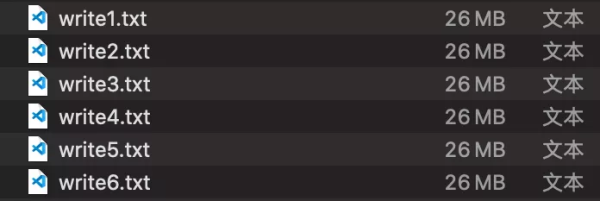
从上述结果可以看出,每种方法都正常写入了 26 MB 的数据,它们最终执行的结果如下图所示:
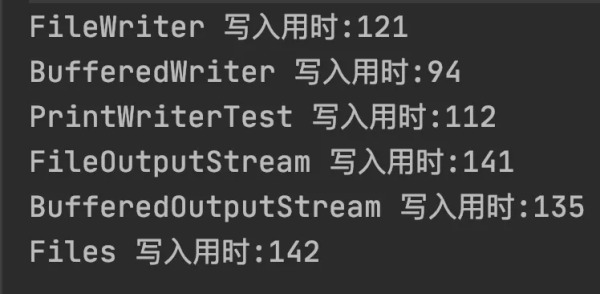
从以上结果可以看出,字符流的操作速度最快,这是因为我们本次测试的代码操作的是字符串,所以在使用字节流时,需要先将字符串转换为字节流,因此在执行效率上不占优势。
从上述结果可以看出,性能最好的是带有缓冲区的字符串写入流 BufferedWriter,性能最慢的是 Files。
PS:以上的测试结果只是针对字符串的操作场景有效,如果操作的是二进制的文件,那么就应该使用带缓冲区的字节流 BufferedOutputStream。
6.扩展知识:内容追加
以上代码会对文件进行重写,如果只想在原有的基础上追加内容,就需要在创建写入流的时候多设置一个 append 的参数为 true,比如如果我们使用 FileWriter 来实现文件的追加的话,实现代码是这样的:
public static void fileWriterMethod(String filepath, String content) throws IOException { // 第二个 append 的参数传递一个 true = 追加文件的意思 try (FileWriter fileWriter = new FileWriter(filepath, true)) { fileWriter.append(content); } }如果使用的是 BufferedWriter 或 PrintWriter,也是需要在构建 new FileWriter 类时多设置一个 append 的参数为 true,实现代码如下:
try (BufferedWriter bufferedWriter = new BufferedWriter( new FileWriter(filepath, true))) { bufferedWriter.write(content); }相比来说 Files 类要想实现文件的追加写法更加特殊一些,它需要在调用 write 方法时多传一个 StandardOpenOption.APPEND 的参数,它的实现代码如下:
Files.write(Paths.get(filepath), content.getBytes(), StandardOpenOption.APPEND);感谢各位的阅读,以上就是“文件写入的方法有哪些”的内容了,经过本文的学习后,相信大家对文件写入的方法有哪些这一问题有了更深刻的体会,具体使用情况还需要大家实践验证。这里是亿速云,小编将为大家推送更多相关知识点的文章,欢迎关注!
亿速云「云服务器」,即开即用、新一代英特尔至强铂金CPU、三副本存储NVMe SSD云盘,价格低至29元/月。点击查看>>
免责声明:本站发布的内容(图片、视频和文字)以原创、转载和分享为主,文章观点不代表本网站立场,如果涉及侵权请联系站长邮箱:is@yisu.com进行举报,并提供相关证据,一经查实,将立刻删除涉嫌侵权内容。
原文链接:https://mp.weixin.qq.com/s/58M72ybgGtjAQJP8_6hDEw